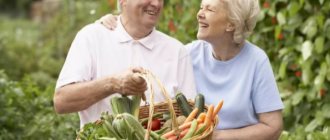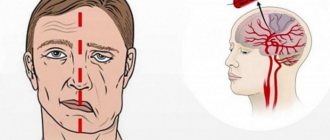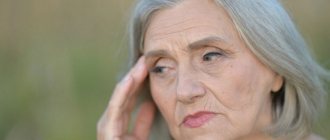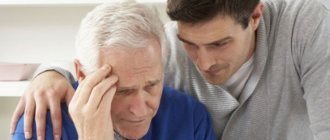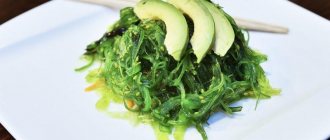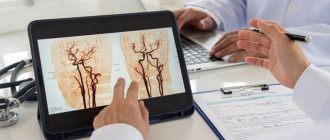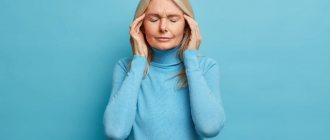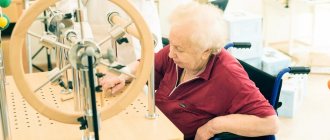Your volleyball > Articles > Nutrition for stroke
A stroke is an acute disorder of cerebral circulation, in which brain cells do not receive enough nutrients and oxygen from the bloodstream, which leads to irreversible damage and even death of neurons. Being the most dangerous critical condition, a stroke often leads to the death of the patient, and those who survive such a vascular catastrophe often remain disabled for life.
Although stroke can affect people of different ages, genders and health conditions, there are risk groups - categories of patients who have an increased likelihood of developing vascular disorders, and in particular stroke. In addition to people suffering from hypertension, atherosclerosis, diabetes mellitus and bad habits, a separate risk group consists of patients who indulge in unhealthy eating habits.
According to the results of recent studies by leading European experts, people who eat properly have a reduced risk of stroke by at least 15-17%. As for the role of diet after a stroke, here the nutritional factor is especially important, because restoring the functional activity of all body systems is impossible without fully saturating the cells with essential nutrients, vitamins and minerals.
Diet goals for stroke
Nutrition plays an important role both in the process of preventing stroke and after a vascular crisis. The principles of the stroke diet are the same and are aimed at achieving the following goals:
- improvement of blood circulation in all parts of the body;
- blood pressure control - preventing blood pressure from rising above 140/90;
- lowering cholesterol levels in the blood and preventing the formation of cholesterol plaques in the vascular bed;
- acceleration of all metabolic processes, especially the stages of fat and carbohydrate metabolism;
- reducing the load on the cardiovascular system, kidneys and liver;
- normalization of the patient's weight.
Creating the right diet for a patient who has suffered a stroke is the most important stage of secondary prevention (preventing a re-exacerbation).
What can you eat if you have a stroke: table No. 10
The main question that arises in the process of prevention and recovery from cerebrovascular accidents is what you can eat during a stroke. Most experts agree that the nutrition of patients in this group should be complete and varied, but the diet involves certain restrictions. An excellent example of the dietary diet of stroke patients is the technique developed by Soviet nutritionists, which was called “table No. 10.”
This technique assumes the following principles:
- Caloric content of the diet. The patient's daily caloric intake should be 2500-2600 kcal. Calorie restriction is achieved by reducing the consumption of simple fats and carbohydrates, which contribute to the development of atherosclerosis and blockage of blood vessels, which provokes a stroke.
- Chemical composition of food. The daily ration of the “table No. 10” diet should contain no more than 400 grams of carbohydrates, 90 grams of proteins (55-60% animal) and 70 grams of fat (25-30% vegetable). A restriction on salt consumption is also being introduced, the content of which in the daily diet should not exceed 6-7 grams.
- Method of preparing food. Meat, fish and vegetables are steamed, boiled or baked without the use of fat and with minimal addition of salt and spices.
- Regularity of meals. The patient is recommended to eat 5-6 times a day in small portions, with equal intervals between meals of approximately three hours. The last meal should be 3 hours before bedtime.
- Drinking liquids. The diet introduces a limit on daily fluid intake at 1.2 liters of clean water per day.
The method of therapeutic nutrition “table No. 10” is based on the following principles:
- First meal. The diet recommends preparing vegetarian soups with vegetable broth. Meat, mushroom and fish first courses, as well as soups containing legumes, are completely excluded from the diet. Vegetable soups can contain potatoes, beets, carrots, tomatoes, and various cereals. The serving of the first course should be from 200 to 400 grams.
- Meat, fish, poultry. It is allowed to eat lean meat - beef, veal, chicken, turkey, rabbit, as well as trimmed pork in small quantities. The meat is boiled, baked, or steamed, and also served as aspic. The consumption of fatty meat is excluded - fatty pork, goose and duck meat, offal (liver, kidneys, brains), smoked sausages, as well as any canned food. Lean fish can be prepared by boiling followed by baking or frying. Fatty fish, as well as salted, smoked and dried fish, caviar and any canned fish are completely excluded from the diet.
- Dairy products. If the patient does not have intolerance, low-fat kefir and cottage cheese are allowed. The “table No. 10” food system allows for limited addition of sour cream, cream and cheese to dishes. Salty and fatty cheeses are completely excluded from the diet.
- Eggs. You can eat 1 egg per day, soft-boiled or served as a steamed omelette or baked in the oven. Fried and hard-boiled eggs are completely excluded from the diet.
- Cereals. The diet includes cereals cooked in water or milk in the form of puddings, as well as pasta. Legumes are completely excluded.
- Vegetables and fruits. The following vegetables are allowed to be consumed: potatoes, cauliflower, tomatoes, carrots, beets, zucchini, pumpkin, cucumbers, lettuce, as well as parsley and cilantro as a seasoning for food. White cabbage and green peas can be consumed in limited quantities. Vegetables can be cooked by boiling and baking with minimal addition of salt. It is advisable to eat more fresh fruits and vegetables. Salted, pickled and pickled vegetables should be excluded from the diet. It is also recommended to completely avoid eating and adding radishes, spinach, sorrel, garlic, onions and mushrooms to dishes. Ripe fruits, fresh berries and dried fruits can be consumed without restrictions. It is also recommended to introduce into the diet compotes, mousses, jelly, honey and jam with minimal sugar content.
- Beverages. Patients can drink weak tea, vegetable and fruit juices (except grape juice), and rosehip decoction. Natural coffee and cocoa are completely excluded.
Compliance with the above recommendations allows you to avoid the development of atherosclerosis, maintain normal functioning of the cardiovascular system and reduce the risk of stroke. Also, “table No. 10” is one of the options for proper nutrition during the recovery period after an acute vascular crisis.
Principles of nutrition
There are several features of the diet, the observance of which will fill the body with nutrients without burdening it. Let's look at each principle separately to assess the importance of each of them.
Calorie content
It is important that the total daily calorie content of all dishes does not exceed 2500 kcal, of which the following combination of components is considered ideal:
- Carbohydrates – 400 g, of which 85% should be complex carbohydrates: porridge, whole grain bread, premium pasta. Carbohydrates saturate the body with energy, but not only their quantity is important, but also their quality. You should avoid sweet and fatty foods, which are also essentially carbohydrates, but do not carry any biological value, only aggravating the patient’s condition, placing increased stress on the liver and pancreas.
- Proteins – 90 g. It is best to give preference to lean meats: chicken, turkey, rabbit. The high content of collagen and elastin helps strengthen the walls of blood vessels.
- Fats – no more than 50 g per day. You should consume fats of vegetable origin (butter, fermented milk products), limiting fats of vegetable origin.
On the first day after a stroke, a gentle diet with a calorie content of no more than 1500 kcal is required. Every day the calorie content is gradually increased to 2500 kcal, introducing new products that stimulate regeneration at the cellular level.
Fractionality
Food should be taken in small portions, but often. The number of receptions should be at least 5-6 per day. Fractional meals allow you to reduce the load on the body, eliminate overeating, and also contribute to the gradual resumption of digestion processes. This technique also allows you to establish intestinal motility, normalizing stool and its frequency. After a stroke, it is important to control bowel movements, since constipation leads to increased pressure during defecation with pushing, which in itself is dangerous.
Temperature
We must not forget that the temperature of the food consumed depends on its digestibility and rate of breakdown. The food in the patient's diet should not be too hot. The temperature of the first courses should not exceed 38°C. You should also avoid excessively cold dishes, which lead to vasoconstriction of the gastrointestinal tract.
Consistency
The larger the food that enters the stomach, the longer the digestion process takes. This is especially true for older people who are unable to fully chew solid food, as well as people with facial paralysis. It is important that all products are served in crushed form. To do this, use a blender, which is convenient to turn any dish into a mushy and puree-like state. Chopped food, given in fractions, is digested several times faster and also does not cause any discomfort during the digestion process.
Attention! Compliance with these nutritional principles will enrich the patient’s body, directing all efforts towards a speedy recovery.
Method and duration of heat treatment
Care should be taken to ensure that the dishes are well prepared, especially for meat and fish. Heat treatment should be carried out for at least 40-45 minutes, which guarantees the destruction of all pathogenic microflora of products.
To reduce the fat content, it is recommended to abandon frying in favor of steaming or cooking dishes in their own juices. A steamer and oven are ideal for this, as well as non-stick pans that allow you to cook without fat.
Do not forget about such an indicator as the severity of the patient’s condition. In case of a major stroke, when a person is in a comatose state, nutrition is provided through a special tube, and special nutritional mixtures are used as food. If the person is conscious, food intake is carried out on the second day after the stroke, when a complete diagnosis of the body’s condition has been carried out and the cause of the attack has been established.
Nutrition in the first days after a stroke
Nutrition during a stroke in the first days after the experience is difficult due to the patient’s serious condition. Eating solid foods is often impossible. In this regard, boiled, steamed or baked foods must be served in the form of puree. Often, patients after a stroke are not able to drink fluids in their normal state, which requires the addition of special thickeners. During this period, experts often recommend introducing baby food into the patients’ diet, which fully complies with the requirements for acceptable products after an acute cerebrovascular accident.
In the first days after a stroke, it is very important to ensure a regular supply of food - at least 5 times a day. Portions should be small (200-250 grams) in order to eliminate the high load on the patient’s weakened body. During this period, most experts recommend completely abstaining from consuming dairy products, as well as any oils and fats. Meat should be introduced into the diet gradually, increasing its quantity in order to minimize the load on the digestive system in the first days after a vascular crisis.
It is very important to saturate the patient’s diet with foods rich in folic acid, which promotes the full restoration of damaged brain tissue. This category of products includes fish, fresh fruits and whole grains.
The Importance of Nutrition in Stroke Rehabilitation
Following a certain diet is as important as taking medications. Stroke rehabilitation involves a whole range of measures, where nutrition plays a leading role. It has been scientifically proven that the lack of proper nutrition in combination with the strongest medications that accelerate recovery somewhat slows down the process. Therefore, it is important to adhere to the basic principles of nutrition and adherence to diet table No. 10.
In addition, continued adherence to dietary recommendations reduces the risk of developing a recurrent stroke several times, which not everyone can survive.
The post-stroke diet has the following goals:
- Saturate the body with proteins - the main building components that will accelerate the regeneration of brain cells.
- Reduce the content of cholesterol in the blood - fat that is not able to dissolve, which leads to its settling on the inner walls of blood vessels, provoking atherosclerosis, narrowing the lumen of the vessel and disrupting normal blood flow.
- Resume metabolic processes in brain cells by saturating them with oxygen.
It is important that a balanced diet is provided to the patient in the first days after a stroke, which will shorten the rehabilitation period and also increase the chances of a full recovery.
Products prohibited for use during stroke
The diet menu for cerebral stroke cannot contain the following products:
- any products made from white flour - muffins, pastries, white bread, pancakes, etc. Preference should be given to coarse rye flour of the 2nd grade;
- fatty and fried foods;
- any canned food, pickles, pickled and soaked vegetables and fruits;
- smoked sausage, smoked fish, smoked meats;
- fatty dairy products (sour cream, cream, full-fat cottage cheese), as well as factory-produced dairy products that have a long shelf life;
- sweets - candies, cakes, cookies, halva, etc.;
- poultry skin due to its high content of toxic substances and hormones;
- fast food, semi-finished products, as well as any products containing a large amount of preservatives and stabilizers;
- radishes, turnips, sorrel, spinach, mushrooms, legumes.
The daily intake of sodium chloride is limited, which is necessary to prevent an increase in blood pressure. It is also advisable to avoid foods containing sugar, since any disorders of carbohydrate metabolism lead to changes in the condition of the vascular wall and provoke various cerebral circulation disorders, including stroke.
You should eat potatoes and pasta no more than twice a week. It is advisable to steam or bake potatoes. A diet after a stroke at home involves supplementing the side dish with foods high in fiber. Grains help lower cholesterol levels. Preference should be given to dark varieties of rice, buckwheat, and wheat cereals, excluding white rice from the diet, the beneficial properties of which are much less pronounced.


